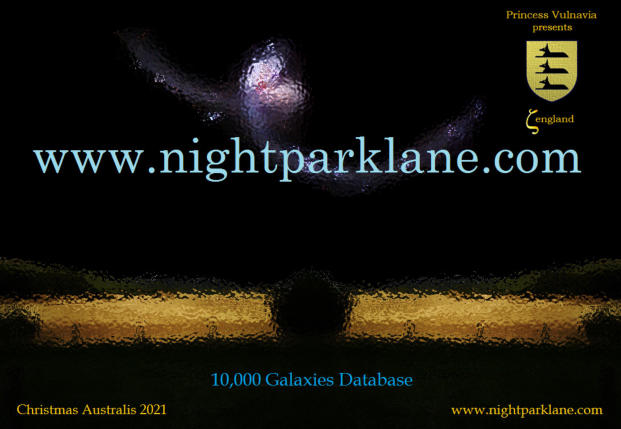



Night Park Lane, The Ethereal Academy of Mathematics, Art and Astronomy.


10,000 Galaxies Database
The current estimate for the number of galaxies in the observable universe is 125 billion.
The first decision was to decide a suitable number of galaxies to use in order to produce
a manageable database. There are 6,060 galaxies from the NGC database which are included
in Stellarium. So these were used to form the initial base. From here, 10,000 seemed like a
tidy total and consequently the aim was to use galaxies listed in other catalogues to achieve
this amount.
The other catalogues used included:
The Arp Catalogue
A catalogue of peculiar galaxies
produced by Halton Arp.
The ESO Catalogue
Hickson Compact Groups
HCG Catalogue
As defined by Paul Hickson (1982),
“a compact group is a small, relatively
isolated system of typically four or five
galaxies in close proximity to one another.”
The Index Catalogue
IC
The Principal Galaxies Catalogue
PGC
The VV Catalogue
A catalogue of galaxies produced
by Vorontsov and Velyaminov.
The Uppsala General Catalogue
UGC
Seven main galaxy classes are included in the database.
1. Galaxy (plain!)
2. Active Galaxy
3. Interacting Galaxy
4. Radio Galaxy
5. Dwarf Galaxy
6. Blazar
7. BL Lacertae Object
Galaxy Type
There are 510 different descriptions used by Stellarium to specify the type of galaxy for the galaxies
which have been selected for the database.
The main 41 galaxy type descriptions are listed in the file “Top Types” and these descriptions
are listed in order of frequency in the file “Top Types Ordered 2021”.
Click on the icons to view the files.
Top Types 2021
Top Types Ordered 2021
Distribution of the 10,000 Galaxies
Across the Constellations
It is interesting to investigate the distribution of the 10,000 galaxies across the constellations.
None of the galaxies lie within the constellations Sagitta, Scutum and Serpens (Cauda)
nor within the constellations Norma, Crux and Musca in the southern skies.
The following lists show the constellations which have the highest concentration of the
selected galaxies.
Northern Skies
Southern Skies
1.
Virgo
767
1.
Centaurus
194
2.
Ursa Major
618
2.
Indus
161
3.
Leo
570
3.
Grus
150
4.
Cetus
562
4.
Phoenix
127
5.
Bootes
459
5.
Pavo
121
6.
Pisces
398
7.
Pegasus
393
8.
Coma Berenices
382
9.
Eridanus (Borealis)
344
10.
Draco
327
11.
Hercules
325
12.
Canes Venatici
309
13.
Hydra
281
14.
Andromeda
205
It is worth pointing out that there are146 selected galaxies within the constellation Serpens (Caput),
as opposed to none in Serpens (Cauda). Also, Scorpius has just three.
For a full list of constellations and the number of galaxies within each class, see the file
“Constellations 2021”.
Click on the icon to view the file.
Constellations 2021
Constellation Maps
The following files show the number of galaxies chosen for the 10,000 Galaxies Database which are
in each constellation on maps of the constellations.
Click on relevant icon to view the required file.
Northern Skies
Southern Skies
Research Questions
Some intriguing questions arose during the production process of the 10,000 Galaxies Database.
These have been summarized and included in the following file “Galaxy Questions”.
Click on the icon to view the questions.
Galaxy Questions
























